
The Indian Air Force (IAF) is the air arm of the Indian Armed Forces. Its primary mission is to secure Indian airspace and to conduct aerial warfare during armed conflicts. It was officially established on 8 October 1932 as an auxiliary air force of the British Empire which honoured India's aviation service during World War II with the prefix Royal. After India gained independence from United Kingdom in 1947, the name Royal Indian Air Force was kept and served in the name of the Dominion of India. With the transition to a republic in 1950, the prefix Royal was removed.
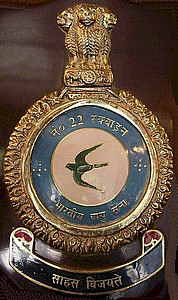
No. 22 Squadron (Swifts) was a CAS unit based out of Hasimara AFS. Along with No. 222 Squadron IAF Tiger Sharks, No. 22 Squadron forms a part of the 16 Wing of the IAF. The squadron operated MiG-27 till December 2017 and the squadron number-plated since then.
The No.3 Squadron (Cobras) of the Indian Air Force (IAF) operates as a Close Air Support (CAS) and reconnaissance unit. Currently based at NAL Air Force Station, No. 3 Sqn falls under the Western Air Command, forms the 46 wing of the IAF.

During the Indo-Pakistani war of 1965, the Indian and Pakistani Air Forces engaged in large-scale aerial combat for the first time. In the air war, which took place in September, both air forces conducted thousands of defensive and offensive sorties over Indian and Pakistani airspace. Both India and Pakistan claimed victory in the air war; Pakistan claimed to have destroyed 104 Indian aircraft and lost 19, and India claimed to have destroyed 73 Pakistani aircraft and lost 35 of its own. The air war ended in a stalemate.
No. 4 Squadron IAF (Oorials) is a fighter squadron of the Indian Air Force (IAF) equipped with the Su-30 MKI, based at Jodhpur Air Force Station in Jodhpur in, Rajasthan, India. Since its establishment during the South-East Asian theatre of World War II, No. 4 Squadron remains the only fighter squadron other than No. 3 Squadron IAF and No. 7 Squadron IAF to remain continuously in existence in the service of India.
No. 20 Squadron (Lightnings) is a fighter squadron. It is equipped with Sukhoi Su-30MKI and based at Lohegaon Air Force Station, Pune.
The No. 224 Squadron (Warlords) of the IAF is a Ground Attack squadron based at Jamnagar AFS. It was temporarily disbanded in 2007 after the retirement of MiG-23MF aircraft. The unit was resurrected in 2008 with Jaguar Darin II aircraft and continues to operate from Jamnagar.
No. 28 Squadron, Indian Air Force, nicknamed The First Supersonics is a squadron of the Indian Air Force (IAF). It is currently based in Adampur, Punjab with the Western Air Command and flies Mikoyan MiG-29s.

No. 14 Squadron (Bulls), is a ground attack unit, operating out of AFS Ambala. The squadron currently operates SEPECAT Jaguar IS and IBs, operational since March 1981.
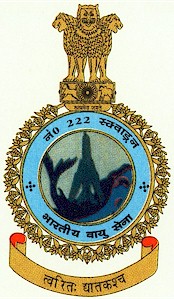
No. 222 Squadron(Tigersharks) is a maritime strike unit based out of Thanjavur. It is the first Sukhoi Su-30 MKI squadron based in southern India and is the also the first squadron equipped with air launched BrahMos cruise missile.
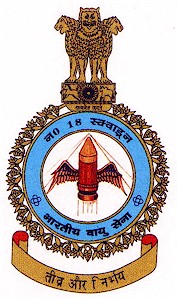
No. 18 Squadron, is an air-defence unit of the Indian Air Force, flying from Sulur Air Force Station. The squadron is equipped with indigenous HAL Tejas MK1 in FOC configuration.

No. 21 Squadron IAF (Ankush), is an Air Defence and Ground Attack unit of the Indian Air Force, operating from Sirsa AFS, as part of 12 Wing of Western Air Command. The squadron was number plated on an unspecified date.
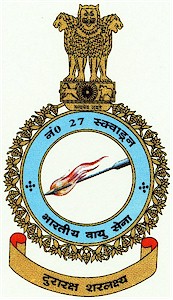
No. 27 Squadron IAF is a Ground-Attack and Close Air Support squadron of the Indian Air Force, operating from Gorakhpur AFS, under Central Air Command.
No. 26 Squadron IAF (Warriors) is a Ground Attack and Close Air Support unit of the Indian Air Force, operating from Pathankot Air Force Station under India's Western Air Command. The squadron was number plated on an unspecified date.
No. 31 Squadron IAF, nicknamed the Lions, is a Ground Attack squadron of the Indian Air Force, equipped with Su-30MKI aircraft operating from Jodhpur Air Force Station.
Squadron Leader Mandepanda Appachu Ganapathy was a fighter pilot and officer of the Indian Air Force, known for his involvement in the Aerial Battle of Boyra during the Indo-Pakistani War of 1971. He was awarded the Vir Chakra for shooting down a PAF Sabre in the above-mentioned aerial battle
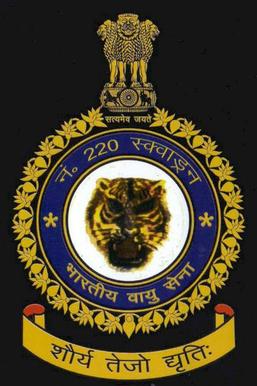
No. 220 Squadron is a fighter squadron and is equipped with Su-30 MKIs and based at Halwara Air Force Station.

No. 45 Squadron Indian Air Force is a Fighter Squadron internally based at Sulur AFS, Tamil Nadu. The squadron operates the indigenous HAL Tejas fighter from 1 July 2016. The squadron was initially based at Bangalore, Karnataka and later shifted to its main base in Sulur from 1 June 2018.

Wing Commander Amar Jit Singh Sandhu VrC, VM was an Indian Air Force officer and fighter pilot. He was awarded the Vir Chakra award and the Vayusena Medal. He is credited with shooting down a Pakistan North American F-86 Sabre in the Indo-Pakistani War of 1965.











